Local flaps of the hand
- PMID: 24731606
- PMCID: PMC4011143
- DOI: 10.1016/j.hcl.2013.12.004
Local flaps of the hand
Abstract
A local flap consists of skin and subcutaneous tissue that is harvested from a site near a given defect while maintaining its intrinsic blood supply. Local skin flaps can be a used as a reliable source of soft tissue replacement that replaces like with like. Flaps are categorized based on composition, method of transfer, flap design, and blood supply, but flap circulation is considered the most critical factor for the flap survival. This article reviews the classification of local skin flaps of the hand and offers a practical reconstructive approach for several soft tissue defects of the hand and digits.
Keywords: Hand flaps; Reconstruction; Soft tissue coverage.
Copyright © 2014 Elsevier Inc. All rights reserved.
Figures



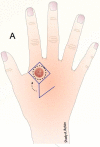








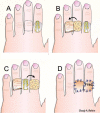


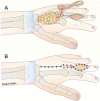

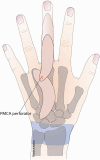

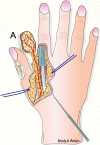


Similar articles
-
[RECONSTRUCTION OF IRREGULAR DEFECTS OF HAND USING LATERAL ARM FREE PERFORATOR FLAP BY PERSONALIZED DESIGN].Zhongguo Xiu Fu Chong Jian Wai Ke Za Zhi. 2015 Dec;29(12):1510-4. Zhongguo Xiu Fu Chong Jian Wai Ke Za Zhi. 2015. PMID: 27044220 Chinese.
-
Hand reconstruction with lobulated combined flaps based on the circumflex scapular pedicle.Microsurgery. 2008;28(5):355-60. doi: 10.1002/micr.20500. Microsurgery. 2008. PMID: 18561269
-
[Effectiveness of retrograde island neurocutaneous flap pedicled with lateral antebrachial cutaneous nerve in treatment of hand defect].Zhongguo Xiu Fu Chong Jian Wai Ke Za Zhi. 2014 Dec;28(12):1498-501. Zhongguo Xiu Fu Chong Jian Wai Ke Za Zhi. 2014. PMID: 25826894 Chinese.
-
[Reconstruction of hand dorsum soft tissue defect using anterolateral thigh perforator flap: description, case study and review of literature].Chir Main. 2011 Feb;30(1):56-61. doi: 10.1016/j.main.2011.01.006. Epub 2011 Feb 1. Chir Main. 2011. PMID: 21334951 Review. French.
-
A reassessment of the role of the radial forearm flap in upper extremity reconstruction.J Hand Surg Am. 2011 Jul;36(7):1237-40. doi: 10.1016/j.jhsa.2011.04.016. Epub 2011 May 31. J Hand Surg Am. 2011. PMID: 21621927 Review.
Cited by
-
Atasoy Flap Reconstruction in the Management of Multiple Fingertip Injuries: A Case Report.Niger Med J. 2022 Sep 10;63(1):82-85. doi: 10.60787/NMJ-63-1-133. eCollection 2022 Jan-Feb. Niger Med J. 2022. PMID: 38798974 Free PMC article.
-
Squamous cell carcinoma in rare case of Huriez Syndrome: The role of distant flaps.JPRAS Open. 2024 Nov 28;43:180-186. doi: 10.1016/j.jpra.2024.11.014. eCollection 2025 Mar. JPRAS Open. 2024. PMID: 39758213 Free PMC article.
-
Distally Based Dorsal Flag Flap for the Fingertip Defects.World J Plast Surg. 2022;11(3):47-52. doi: 10.52547/wjps.11.3.47. World J Plast Surg. 2022. PMID: 36694680 Free PMC article.
-
Patient satisfaction after innervated digital artery perforator flap for fingertip injuries.Acta Orthop Traumatol Turc. 2020 May;54(3):269-275. doi: 10.5152/j.aott.2020.03.1. Acta Orthop Traumatol Turc. 2020. PMID: 32544063 Free PMC article.
-
Double V-Y Island Pedicle Flap for Dorsal Hand Reconstruction Following Mohs Micrographic Surgery.Cureus. 2023 Sep 15;15(9):e45314. doi: 10.7759/cureus.45314. eCollection 2023 Sep. Cureus. 2023. PMID: 37846246 Free PMC article.
References
-
- Hegge T, Henderson M, Amalfi A, Bueno RA, Neumeister MW. Scar contractures of the hand. Clin Plast Surg. 2011 Oct;38(4):591–606. - PubMed
-
- Upton J, Havlik RJ, Khouri RK. Refinements in hand coverage with microvascular free flaps. Clin Plast Surg. 1992 Oct;19(4):841–57. - PubMed
-
- McGregor IA. Flap reconstruction in hand surgery: the evolution of presently used methods. J Hand Surg Am. 1979 Jan;4(1):1–10. - PubMed
-
- Rockwell WB, Lister GD. Soft tissue reconstruction. Coverage of hand injuries. Orthop Clin North Am. 1993 Jul;24(3):411–24. - PubMed
-
- Giessler GA, Germann G. Soft tissue coverage in devastating hand injuries. Hand Clin. 2003 Feb;19(1):63–71. vi. - PubMed
Publication types
MeSH terms
Grants and funding
LinkOut - more resources
Full Text Sources
Other Literature Sources
Medical

